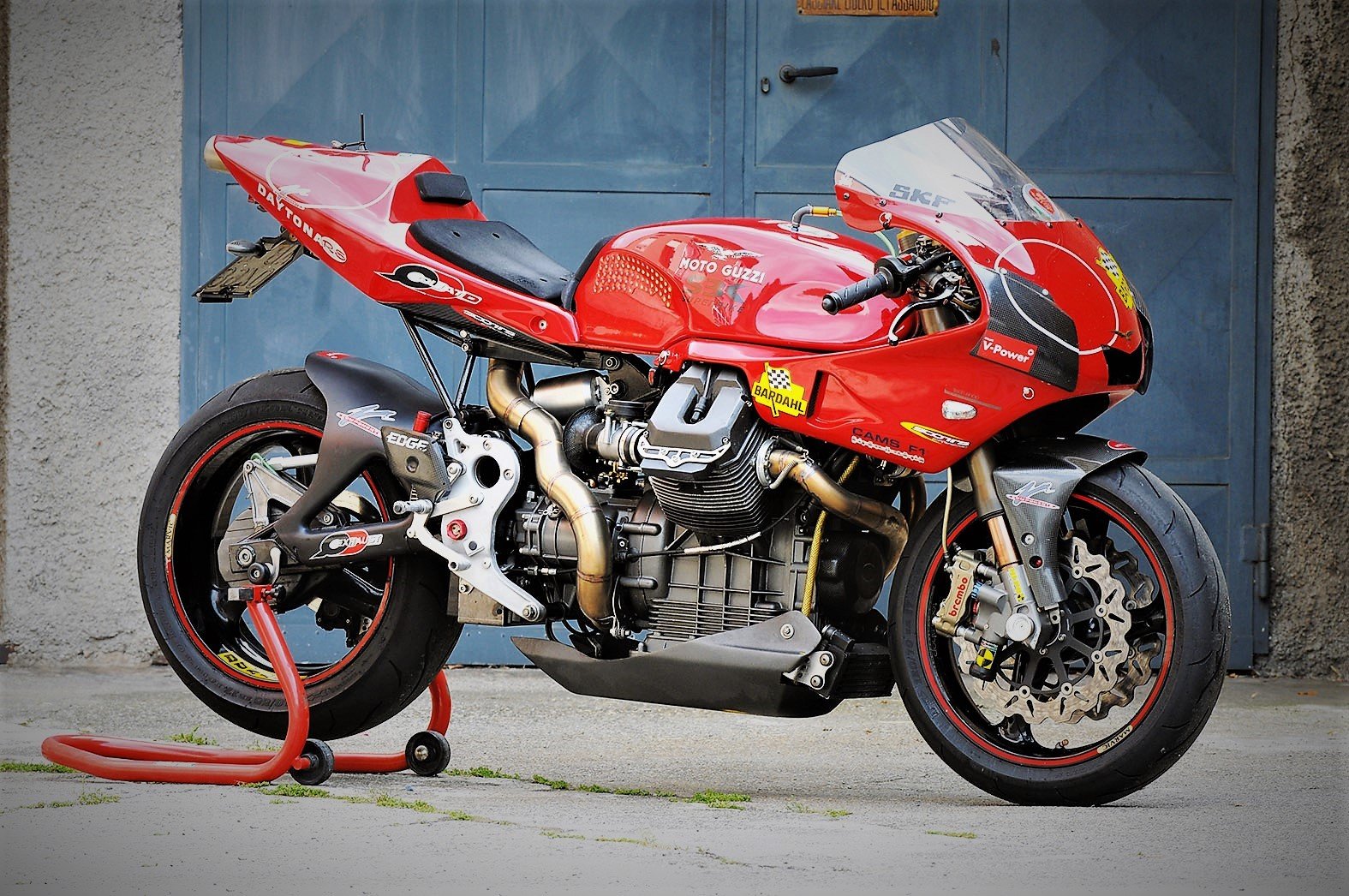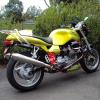-
Posts
5,449 -
Joined
-
Last visited
-
Days Won
276
Content Type
Profiles
Forums
Events
Gallery
Community Map
Everything posted by Lucky Phil
-
Nice one scudd, but I'm not sure about the green vents. Up there with Chucks red fork gators I think. The Ducati gods may take revenge on you:) Ciao Hmm... perhaps I have angered the duck-gods. She gave me a crank-but-no-start right after this. Hopefully fixable this weekend, parts have been delivered. I'm not "sure" about the green vents either. But it's just a wrap that I could remove easily if I want to. Plus, I think it's a better idea than buying a Benelli Tornado. As for geniuses... they don't always dress well. Really? what do you suspect is the no start issue? Hope for me yet then, I can't tick the snappy dresser box I'm afraid. Ciao
-
Along with the crazy people Chuck Ciao Some times, the difference between crazy and genius is simply a matter of time.. Personally I'm banking on that being the case Chuck:) Ciao
-
Just want to re-acknowledge the fine work you and Chuck are doing here Scudd. This all takes time and communication and checking and re-affermation and its a process. Thanks again chaps. Ciao
-
Dear me, and I thought our motto was "The Ride Starts Here!" I should have a banner made for my shop: "The Mistakes Start Here." Best shop banner ever. High quality Fast service Cheap cost Choose any two Ciao
-
Maybe! My workbench misses having an engine on it. Sent from my SAMSUNG-SM-G930A using Tapatalk BTW your shift lever is hitting the pork chop on the down shifts. Ciao
- 41 replies
-
- 1
-

-
- transmission
- shifting
-
(and 1 more)
Tagged with:
-
Now mate this isnt going to be another "rebuilt V11 Sport wont start" 10 pager that ends with "I pulled it all apart found nothing wrong, put it back together and its fine now" deal is it. Ciao
- 41 replies
-
- 1
-

-
- transmission
- shifting
-
(and 1 more)
Tagged with:
-
Along with the crazy people Chuck Ciao
-
Oh, yeah. The material is essentially free. All the money is in the time to make them. I should have just stepped up and made them in the first place. They would have been done and forgotten about by now. It just reminded me entirely too much of work.. and.. a place that does this commercially should be tooled up and be able to make them for considerably less than I can. Its all good Chuck, mistakes are made. Lets see what the spring guy says, Now he knows that the customer will be doing the QC he might be a little more focused on getting the specs spot on. Ciao
-
Didnt realise we had figured it out! Ciao
-
Nice one scudd, but I'm not sure about the green vents. Up there with Chucks red fork gators I think. The Ducati gods may take revenge on you:) Ciao
-
I dont believe the plug and play reg will have the slow draw, its the direct connected one that does that. The P&P runs through the ignition switch as per standard. Ciao
-
While we're on old addages chuck, how about "nothing is impossible to the man that doesnt have to do it himself". I love a meandering thread. As long as it teaches you something:) Ciao
-
I'm with the share any additional cost and do it right position, so count me in on that. I mean "should be ok" has its place but when you're trying to overcome a cronic issue its not really where you want to be. Ciao
-
There was a lot of theory in that piece most of which applies more to the track where the bike transitions are more extreme, although I dont see how you trail brake into a turn with the throttle still somewhat open. Maybe I read it wrong. No matter whether you're on the track or the road you are either on the brakes or on the throttle not both at the same time, with two exceptions. On the track you can sometimes use the rear brake accellerating out of a corner to stop the bike wheelying, saves you getting out of the throttle to control the wheelie and also dragging the back brake in the turn can help the bike hold a tighter line. My view is that trail braking is by and large for the race track, if you're using it to any great extent on the road then like Micky D says you should have your speed established by the turn in point by and large. If you're braking all the way to the apex on the road like a racer does on the track then its only a matter of time before it catches up with you. As for the reference to trail braking reducing fatigue on long rides, well thats la la land for mine. Ciao
-
Yes, that would be Micky D. Ciao
-
Excellent scudd, if possible I'll take I dont know maybe around 15 or 20 and people on this side of the pond can contact me and I can forward them on to ease the shipping hassle for you, if you have enough of course. Ciao
-
Thats why track days are such a valuable thing, you can push the limits in relative safety. I think if your not doing track days then you're not serious about improving and maintaining your riding skills. Its not about setting "lap times" but about improving and learning new techniques and practicing the already known ones without the risk, like really heavy braking and looking through the corner and weighing the pegs. Things that you tend to drift away from riding on the road all the time. Every first session on the track is the re familiarise session of looking through the corner, using footpeg weight esp on the long fast corners, not trying to ride the bike all through the bars and feeling the force of really heavy braking, together with getting your brain ahead of the bikes speed. Ciao
-
I have a spare wheel that I was going to powder coat, and I'd rather not take the spacer out of the original if I didn't have to. Just hoping someone has a spare from a wrecked wheel. Ken You will need to remove the wheel bearings to powder coat the wheel I believe. The temps involved are a bit high to expect the bearing grease and seals to cope. Ciao
-
Really? I mean this is a pointless exercise, totally unuseable. It doesnt even break any new design boundaries or ideas, even the totally useless "arty" stuff has been done before plenty of times over the years. Ciao
-
Yes its critical dont think of assembling it without the spacer. It takes the compressive load when tightening up the axle or axle nut depending on your year model through the inner bearing races. If its not fitted that load will be transmitted through the bearings roller balls to the outer race and the lateral forces will create very high friction and the bearings will fail extremely quickly. Ciao
-
This video has nothing to do with countersteer, its about the rear brake. Whats triggered this off is jumping on the rear brake in a panic and then the rest is the a consequence of that. You can see the bike step out a fraction from the rear before the supposed wrong countersteer motion at the very beginning in slow mo. After that its all over and the rider is trying to wrestle with the consequences of the initial rear break away, running wide, being on the wrong line to start with panic and a mini tank slapper caused bu the initial action on the back brake and slamming the throttle shut while banked over and the unsettling effect this has caused to the steering. Ciao
-
I'm with you Chuck, most customised bikes in general prioritise uniqueness and artistic expression over dynamic functionality. Let's face it making it beautiful OR functional is easy, combining both is where the real talent in design and engineering lies. Ciao
-
You know I think this was an "engineering" topic as much as anything that has now taken on a extra philosophical element which I kind of enjoy:)Some of the best threads end up this way. You learn about the engineering and get the life lessons for free. Ciao
-
I'd be more concered Chuck with how the nylon would react to transmission fluid over time. Ciao I use them in many applications. Zero issues with oil or transmission fluids. Ok, was just thinking about those guzzi boxes that had plastic bearing cages that didn't tolerate gearbox lube and would fail. People updated them to metal cages from memory. Ciao
-
Exactly doc:) didn't realise there was a recognised "thing" for it. Ciao


